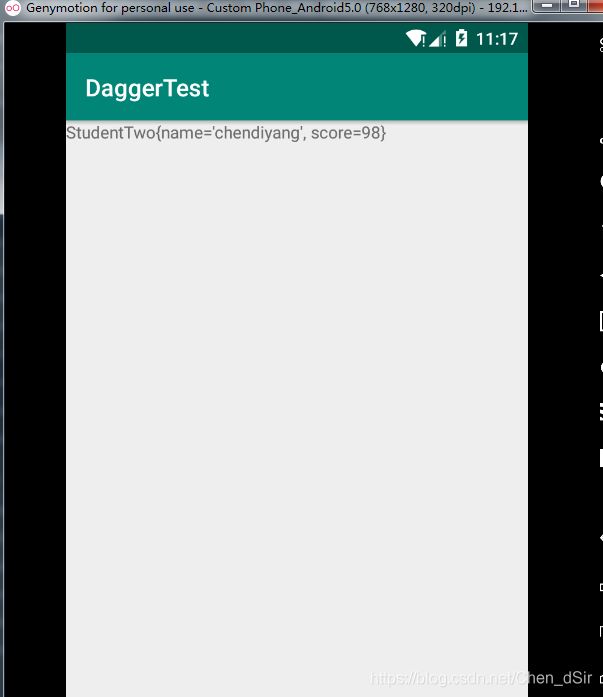Dagger2初探(一)
Dagger2是Android中依赖注入的一个类库,主要就是用来实现自动实例化的,也就是说我们不需要通过new这个关键字来实例化某个对象。而是通过Dagger2的依赖注入方式来实现.它的好处就是降低程序的耦合度。比如如果A的构造函数发生了改变,而B的构造中又使用到了A,那么B也需要修改。这只是两个,假如有更多的地方使用到了A,那么修改起来就会很繁琐。因此Dagger2正好能够带给我们便利。
那么首先,我们就来配置我们的Dagger2吧。
Dagger2中的Android Studio gradle配置:
implementation 'com.google.dagger:dagger:2.14.1'
annotationProcessor 'com.google.dagger:dagger-compiler:2.14.1'配置完成之后,Sync now一下,这样我们就可以开始使用Dagger2的各种注解了。
依赖注入的第一种:@Inject注解类的构造函数
首先,新建一个Student类:
public class Student {
private String name;
private int score;
@Inject
public Student(){
this.name = "chendsir";
this.score = 95;
}
public Student(String name, int score) {
this.name = name;
this.score = score;
}
@Override
public String toString() {
return "Student{" +
"name='" + name + '\'' +
", score=" + score +
'}';
}
}我们可以看到在Student的无参构造函数中,有一个@Inject的注解,这是实现依赖注入的第一种方式,然后我们创建一个StudentComponent的接口:
@Component
public interface StudentComponent {
void inject(MainActivity activity);
}
Component是将Student这个类与需要Student的实例化对象的MainActivity相关联起来。则MainActivity中的代码如下:
public class MainActivity extends AppCompatActivity {
@Inject
Student su;
TextView tv;
@Override
protected void onCreate(Bundle savedInstanceState) {
super.onCreate(savedInstanceState);
setContentView(R.layout.activity_main);
tv = findViewById(R.id.id_tv_content);
//DaggerStudentComponent需要在Rebuild之后才能识别,它是Dagger2自动生成的类
DaggerStudentComponent.builder().build().inject(this);
getStudentInfo();
}
public void getStudentInfo() {
tv.setText(su.toString());
}
}其中有一个DaggerStudentCompoent是需要Rebuild一下项目,Dagger2自动帮忙生成的类,不然无法识别。同时我们也发现了在依赖需求方MainActivity中,它的成员变量Student上面有一个@Inject注解,同时Student类的构造函数上面也有一个@Inject注解,从这里我们可以看到@Inject不但可以作为依赖需求方,也可以作为依赖提供方。
那么运行一下,我们可以看到,APP上面的运行结果如图所示:
依赖注入的第二种实现:
使用@Provides+@Module方式提供依赖实例
实际上第二种才算Dagger2的常用用法,那么我们先创建一个类StudnetTwo:
public class StudentTwo {
private String name;
private int score;
public StudentTwo(String name, int score) {
this.name = name;
this.score = score;
}
@Override
public String toString() {
return "StudentTwo{" +
"name='" + name + '\'' +
", score=" + score +
'}';
}
}然后再创建一个类StudentTwoModule:
@Module
public class StudentTwoModule {
@Provides
public String providerName() {
return "chendiyang";
}
@Provides
public int providerScore() {
return 98;
}
@Provides
public StudentTwo provideStudentTwo(String name,int score) {
return new StudentTwo(name,score);
}
}可以看到在这个类的前面有一个@Module注解,表面这个类就是用来做实例化的,@Provides注解就是来提供不同的数据的。与第一种方式一样,我们也需要建立一个StudentTwoCompoent这个接口,它的作用就是将依赖提供方和依赖接收方建立联系,也可以称为依赖注入容器。
@Component(modules = StudentTwoModule.class) //表面数据源由StduentTwoModule提供
public interface StudentTwoComponent { //Component一个是接口,相当于中间件
void inject(ThirdActivity activity); //这个是数据注入的地方,可以是Activity、Fragment、Java对象
}
最后,看看ThirdActivity中的代码:
public class ThirdActivity extends AppCompatActivity {
@Inject
StudentTwo studenttwo;
TextView textView;
@Override
protected void onCreate(Bundle savedInstanceState) {
super.onCreate(savedInstanceState);
setContentView(R.layout.activity_third);
textView = findViewById(R.id.tv_content_three);
DaggerStudentTwoComponent.builder().build().inject(this); //DaggerStudentTwoComponent是Dagger框架自动生成的
getStudentInfo();
}
public void getStudentInfo() {
textView.setText(studenttwo.toString());
}
}在使用DaggerStudentTwoComponent之前,要记得Rebuild一下,它是Dagger2自动生成的类。最后的运行结果,如图:

